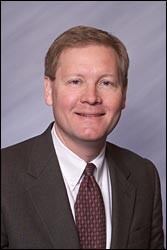 Jerry L. Anderson |
Drake University law professor Jerry L. Anderson and his writing partner Dennis D. Hirsch recently published the third edition of their textbook “Environmental Law Practice: Problems and Exercises for Skills Development.”
The book, published by Carolina Academic Press, has had its previous editions adopted into the curricula of dozens of law schools nationwide, including Columbia Law School, Boston College Law School and the University of Southern California Gould School of Law.
Anderson, who serves as the Richard M. and Anita Calkins distinguished professor of law at Drake, and Hirsch, professor of law at Capital University Law School in Columbus, Ohio, have received praise for the book’s in-depth, professional approach.
“The Anderson and Hirsch book is an eye-opener for students, giving them what is often their first and only competent entree into the world of regulatory practice,” said Zyg Plater, professor of law at Boston College Law School. “Looking back on the exercises, my students tell me they cannot imagine how they could have felt confidence in their understanding of the field, and by extension other fields of law as well, if they hadn’t been introduced to Anderson and Hirsch.”
Updated to include current developments in environmental law, such as recent Supreme Court and circuit court cases, the new edition covers the most significant areas of environmental practice: compliance, enforcement, litigation and policy. It also gives in-depth treatment of substantive environmental law areas such as the Clean Air Act and Clean Water Act.
“There is a big push now in the legal academy for more attention to professionalism and skills training,” Anderson said. “This book, just like Drake Law School in general, is ahead of the curve in terms of specialized instruction.”
A previous edition of the textbook won an award in recognition of innovative teaching of problem solving techniques from the CPR Institute for Dispute Resolution..
In January, Anderson will give a lecture on teaching professionalism based on the book on a panel at the Association of American Law Schools annual convention.
The hidden side of zoning practices
Anderson has also recently received attention from the New York Times’ Freakonomics Blog, which cited a 2008 study conducted by Anderson on the issue of zoning board representation.
Anderson and his collaborators, Drake alumni Aaron Brees, LW’07, and Emily Bartekoske, LW’09, published “A Study of American Zoning Board Composition and Public Attitudes Toward Zoning Issues,” to determine whether attitudes toward controversial land use issues vary according to demographic factors, including occupation.
The study found that certain types of professions — business, real estate, law, bankers, planners and architects — are disproportionately represented on zoning boards. In some cities, the majority of board members have some direct or indirect interest in the development process.
The authors argue that this disproportionate representation may lead to predictable building patterns, such as the prevalence of urban sprawl and gated communities. The composition of zoning boards may also help explain why high-impact land uses are located most often in poorer sections of town.
At the conclusion of the article, the research team recommends that cities attempt to appoint a broader, more diverse cross-section of community members to zoning boards.

